 We live in a country where buckets have warnings on them, but the greatest indignity of our present nanny state is that the Man does not want us to eat raw cheese. As Jean Anthelme Brillat–Savarin put it, “A meal without cheese is like a beautiful woman who lacks an eye” and if that cheese was made with crappy pasteurized, homogenized and sterilized milk it ain’t worth eating.
We live in a country where buckets have warnings on them, but the greatest indignity of our present nanny state is that the Man does not want us to eat raw cheese. As Jean Anthelme Brillat–Savarin put it, “A meal without cheese is like a beautiful woman who lacks an eye” and if that cheese was made with crappy pasteurized, homogenized and sterilized milk it ain’t worth eating.
That’s why you’ve got to make your own cheese. We forget, in our age of individually plastic wrapped crap-ass single-sliced cheese, that the act of cheese making is a way to preserve dairy products and that it’s well within the capabilities of the do it yourself kitchen revolutionary.
Here’s the catch. You’ve got to use raw, un-pasteurized, and un-homogenized milk. It’s possible to make cheese with the pasteurized shit, but it won’t taste as good and you’ll have to add calcium chloride to make it work. We’ve tried using regular milk and it’s a crap shoot–sometimes it works and sometimes it doesn’t even with the calcium chloride. Milk labeled “ultra-pasteurized” will definitely not work.
Now pasteurization is for wimps and worry warts. All of the tainted milk scares in the past few years have been with pasteurized milk. Those factory farm dairy cow concentration camps out there that produce most of the milk in this country figure that they don’t have to be clean since they are pasteurizing everything. Fortunately raw milk is available at health food stores–we used a brand called Organic Pastures.
Making cheese is actually fairly simple and can be done with just milk and rennet, also available in the baking section of health food stores such as Whole Foods. One other nice thing for the vegetarians out there is that you can use vegetable rennet rather than the animal based rennet that is used in most cheese.
Homegrown Revolution recommends that you start your cheese experiments with soft cheeses which are easier to produce. The Neufchâtel recipe that we used to produce the cheese pictured above can be found on the nicely illustrated cheese making website of biology and chemistry professor David B. Frankhauser. Frankhauser’s website is an excellent introduction to cheesemaking.
 To make Neufchâtel you add rennet and let the milk sit out in a stainless steel pot overnight. If all goes well, the next day the milk solids called curds, should have separated from the liquid which is called whey. You place the curds in a piece of cloth, and suspend it over a bowl in the refrigerator. The next day the cheese is ready to form in a mold and serve.
To make Neufchâtel you add rennet and let the milk sit out in a stainless steel pot overnight. If all goes well, the next day the milk solids called curds, should have separated from the liquid which is called whey. You place the curds in a piece of cloth, and suspend it over a bowl in the refrigerator. The next day the cheese is ready to form in a mold and serve.
The verdict on Homegrown Revolution‘s cheesemaking experiments–though urban cheesemaking is somewhat costly due to the high price of raw milk, it’s very satisfying to know that we can make our own cheese and patronize dairies that have more ethical standards. Or maybe it’s time to get our own dairy herd.
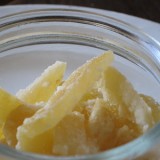
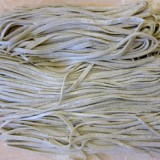
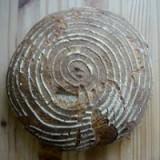
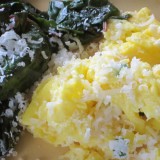
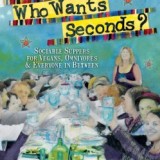
my questions:
– what’s the raw milk availability in l.a.?
– how far is it coming from?
– what’s the price per gallon?
my offering:
michigan mennonites were servicing chicago until they were busted for crossing state lines. now i am driving three hours north to sheboygan, wi to buy 10-20 gallons at a time and freezing it until i make cheese. i pay $4/gallon.
A long list of sources for raw milk can be found at:
http://www.realmilk.com/where1.html
The Organic Pastures milk we used for the cheese comes from Fresno which is about 220 miles north of Los Angeles.
Organic Pastures is about $7 for a half gallon at Whole Foods.
I thought I should let you know that in Steven Spielberg’s ‘Munich’ the rich French anarchist tells the exiled Mosad assassin in Brooklyn that he’s sending him a parcel of cheese. “Real cheese, the kind you can’t get in America — it isn’t pasteurized, so it doesn’t taste like shit.”
Just after watching that movie, I randomly opened the new issue of BLAB (a high end comic book) to a story called ‘The Pungent Gaul’ about a raw milk cheese smuggler who regularly delivers “his fetid contraband to the backrooms of America’s finest cheese merchants.”
From the Wikipedia entry on radical McDonalds smashing French farmer José Bové,
“The United States had placed tariffs on the importation of Roquefort cheese as punishment for the European Union’s restrictions on importing hormone-treated beef. In one of his books, Mr Bové tells the story on how subsequently, he travelled to the United States with thirty kilograms of Roquefort in his luggage, and how he was let in.”
We have been getting milk from two farmers, both are ~1 hour west of Milwaukee, WI. We pay $3/gallon and $3.50/gallon.
You’ve mentioned the rennet in both this blog and the one about the dog cheese. I’m veggie, but may be able to get to some nice fresh milk -directly from the cow. What is the rennet made of? I ask as generally I think they’re made of animal stomach chemicals.
Anonymous,
Yes, rennet is an animal product. However, there are vegetarian rennets that you can order. I think I might have even seen some at Whole Foods.
can you make the cheese without Rennet?
As Erik says above, there are vegetarian rennets, if that is your concern. Otherwise, there are some kinds of cheese that don’t require rennet, like ricotta, or the very simple but tasty yogurt cheese.
Yes, heat the milk to between 120 & 140 degrees, then add white vinegar and stir to separate curds from whey and remove from heat, strain, rinse with cold water, press into a mold and store in frig or serve.